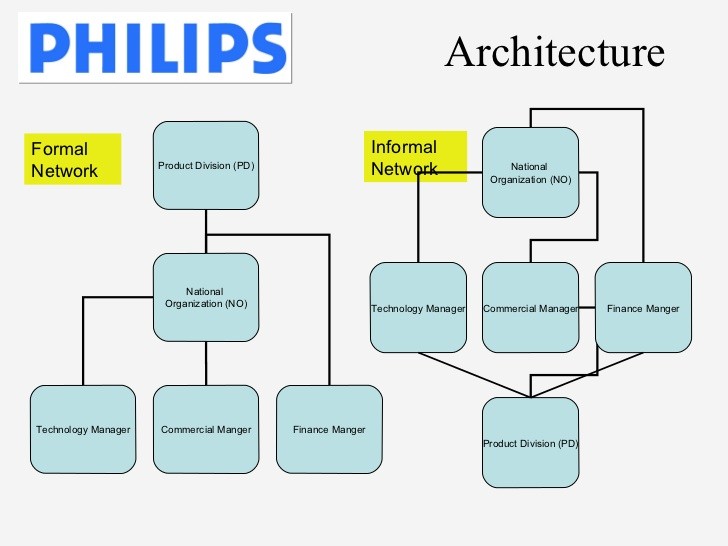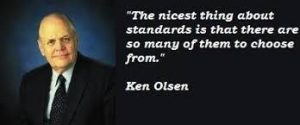A matrix organizational structure is a company structure in which the reporting relationships are set up as a grid (a network of lines that cross each other to form a series of squares or rectangles), or matrix, rather than in the traditional hierarchy. In other words, employees have dual reporting relationships – generally to both a functional manager and a project manager. Matrix management is a structure for running those companies that have both a diversity of products and a diversity of markets. Usually, MNCs prefer to adopt this structure.
In a matrix structure, responsibility for the products goes up and down one depending on the product’s dimension such as pricing, distribution and the target market. This enables the business to use its marketing resources more efficiently, resulting in more cost and time efficient marketing efforts. This leaves most managers with a dual reporting line: to the head of their product division on the one hand, and to the head of their geographical market on the other. Regardless of the potential confusion, the Matrix structure creates vibrancy. Matrix management was enormously popular in the 1970s and 1980s. Famous company like Philips, the Dutch multinational electronics company, was the first company to set up a matrix structure after the Second World War. It had national organisations (NOs) and product divisions (PDs), and for a while they operated successfully as a network. The network was held together by a number of coordinating committees, which resolved any conflict between the two.
The possibility of changing the organizational structure came after some years, at a point when the company took little time to ponder over the profit and loss account. Who was to be held accountable for it? At first, the answer was both the NOs and the PDs. But this was unacceptable, and the NOs ultimately got the upper hand. Philips’s PDs did not like that, and they fought back. In the 1990s, when the company was not doing so well, its organisational structure was completely refurbished. A few powerful PDs were given worldwide responsibility for the profit and loss account, and the NOs became subservient to them.
Another example is of Digital Equipment Corporation founder Ken Oslen who popularized Matrix structure Management. There was virtually no organizational structure in the early years of the company’s existence. The company was founded in 1957 with a $70,000 loan; it became America’s second-largest computer company, after IBM. Its initial major impact was in minicomputers, but its later-introduced VAX and Alpha systems are still notable. Olsen wanted to create a setting like that of the research labs at Massachusetts Institute of Technology (MIT), where he was educated. In fact, Universities adopt Matrix structure because it is most suited to them. Also initially Digital did not lease its computers. It did not create software for its products or offer maintenance services. This policy cut down on the company’s costs, which in turn caused its products to be cheaper than those of their competitors. By 1964 the company required some organizational structure, as various engineering groups were not coordinating well with other functions of the company. Olsen structured the company in a matrix framework, which involved product line managers. Each manager had complete responsibility for a product line, from conceptualization to sales, and was accountable for its performance. Using this structure, the company had developed over twenty new product lines by the mid-1970s. The company got acquired by Compaq in 1998. However, Compaq had little idea what to do with its acquisitions, and soon found itself in financial difficulty of its own. The company subsequently merged with Hewlett Packard (HP) in May 2002. Some of DEC’s product lines were produced under the HP name till end of the decade.
ABB (ASEA Brown Boveri) is a Swedish-Swiss multinational corporation headquartered in Zurich, Switzerland, operating mainly in robotics, power, heavy electrical equipments, and automation technology areas. By creating a matrix organizational structure and establishing global and regional management, ABB earned many benefits. The operations of frontline operating companies were integrated with ABB’s worldwide operations through the matrix. As a result, these companies got an international identity, and their exports increased. The companies got access to the worldwide distribution network of ABB, through the matrix structure. For example, ABB Stromberg (Stromberg before restructuring), a Finland-based company, which manufactured electric drives, transformers, circuit breakers, generators, transformers, etc. was not financially performing well, despite its wide range of products, as all its products were not of international quality standards. ABB’s local operations were organized within the framework of a two-dimensional matrix. ABB’s matrix structure evolved over time it has been reorganized several times in search of the best organizational structure. This is a good example of the emphasis placed on structure as a solution to matrix issues. Organizational Structure plays a vital role in synergising its resources and using people’s skill set.
Using Matrix structure has its advantages and disadvantages. In an article in Harvard Business Review in 1990, Christopher Bartlett and Sumantra Ghoshal suggested that the problems faced especially by multinationals were of dual reporting which leads to conflict and uncertainty. The proliferation of multiple channels creates informational log-jams as a creation of committees and its reporting bog down the organisation. Responsibilities of managers overlap; they report to more heads and this overlapping produce clashes and accountability becomes unclear. MNCs are separated by barriers such as distance, language, time and culture. These realities make nearly impossible to clarify the confusion and resolve the conflicts.
Barlett and Ghoshal upheld the fact in their article that matrix management had been part of an attempt by companies to create complicated structures that matched their increasingly complicated strategies. They felt it focused only on the anatomy (framework) of the organisation. It ignored the physiology (the systems that allow information to flow in and around the organisation) and the psychology (the philosophy – shared norms, values and beliefs of the organisation’s managers).
The matrix organization structure is a blend of the projectized organization and functional organization. Projectized organization which means the project manager has full power and authority over resources to be utilized in the project. He controls the budget, resources, and work assignments. For example, all engineers may be in one engineering department and report to an engineering manager, but these same engineers may be assigned to different projects and report to a different engineering managers or a project manager while working on that project. Therefore, each engineer may have to work under several managers to get his or her job done.
Quite a lot of early literature on the matrix comes from the field of cross functional project management where matrices are described as strong, medium or weak depending on the level of power of the project manager. While some form of matrix management has become fairly common in certain industries, particularly among companies that have multiple business units and international operations, upon closer inspection, different organizations implement a matrix structure in different ways to support their needs.
Resources can be used efficiently in Matrix structure, since experts and equipment can be shared across projects. Products and projects are formally coordinated across functional departments. Information flows both across and up through the organization. Clear articulation of project objectives is possible. It offers workable way of integrating project objectives with functional objectives. Human resources can be used efficiently.
Matrix structure remained in fashion till 1980s but in terms of work flow and reporting they have negative consequences. Individuals need to define and redefine their roles in the organization as they are interdependent. Accountability becomes horizontal instead of vertical. Hence it appears like a diluted structure.















































